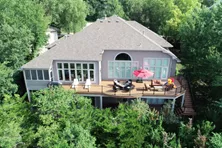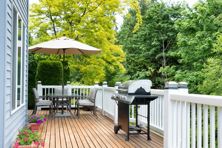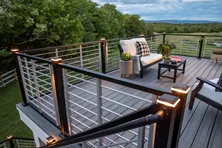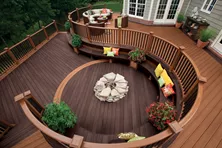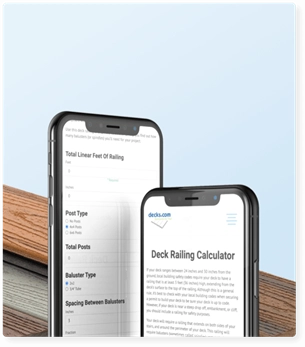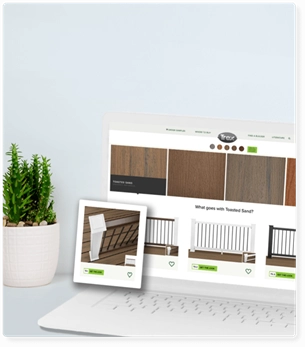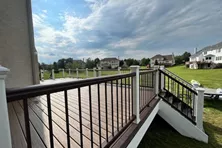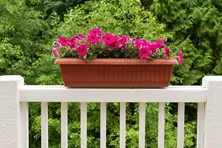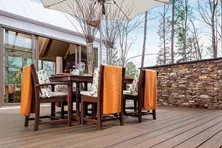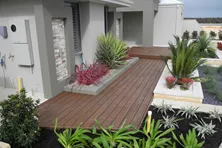Baluster Basics: Types, Installation Tips, and Deck Design Ideas to Transform Your Space
Baluster 101
Deck balusters form the backbone of any safe deck and provide a principal style statement of your outdoor living area. Whether you're building a new deck or reviving an old one, choosing the right balusters can elevate your space from functional to fabulous. This guide covers top materials, spacing guidelines, and some sleek infill alternatives. It even provides pro installation tips and answers some frequently asked questions.
What Are Balusters?
Balusters, sometimes called spindles, are the vertical components that fill the space between your deck’s railing posts and rails. Their primary job is to prevent accidents by keeping people (and pets) from falling off elevated decks. But they’re more than just a safety feature for your deck—today’s balusters come in a variety of materials, styles, colors and configurations, allowing you to customize your deck’s look to compliment your home’s personality.
Baluster Spacing and Height Requirements
Local building codes will regulate the spacing of balusters. These rules are intended to protect small children by minimizing gaps that could cause entrapment or lead to falls. The most common codes state that a 4-in. sphere should not be able to pass through any opening in the railing system, whether between two balusters, between a post and a baluster, or between the bottom rail and the decking. For stair railings, slightly wider openings are allowed: the gap between balusters can be up to 4-3/8 in. Additionally, the triangular space formed by the stair tread, riser and bottom rail must be small enough to block a 6-inch sphere. The two most common height requirements (measured from the top rail to the decking) are 36 in. and 42 in. high. Building codes can vary from one municipality to another, so always check with your local building official to find out what the rules are in your town.
Baluster Material Options
Choosing the right baluster material can have a big impact on the look, feel, and maintenance needs of your deck or railing. Here's a quick overview of the most common baluster options, highlighting their key characteristics and considerations.
- Wood: Wood balusters create a traditional, natural appearance and can be painted or stained any color. However, they require regular upkeep to prevent decay and maintain their appearance. New wood balusters are also prone to warping as they dry.
- Vinyl: Sometimes referred to as PVC, vinyl balusters are a low-cost option, usually available in white. They can feature either square profiles or more traditional turned (spindle) shapes. Vinyl balusters tend to be made from thinner material, which can feel less sturdy and may become brittle with prolonged sun exposure.
- Composite: Composite balusters offer long-lasting performance with minimal maintenance. They are available in multiple colors designed to match or complement composite decking.
- Steel: Steel and iron balusters can provide a strong, classic look, but are also available in unique strap-like shapes. Steel is durable but requires upkeep to maintain its paint finish and prevent rust especially in wet regions.
- Aluminum: Narrow, aluminum balusters combine durability with an open, unobstructed look. They are highly resistant to corrosion, require little maintenance, and are often backed with some of the longest warranties available.
Style and Finish Options
Choosing the right baluster style and finish can significantly impact the overall look of your deck. One approach is to match your baluster color to your decking or house trim for a cohesive, seamless appearance. This creates a polished, unified look. Alternatively, contrasting colors, like black balusters paired with lighter posts, rails and deck boards can create eye-catching definition and highlight the railing system as a design feature.
Baluster size also plays a role in shaping the overall style:
- Slim, round balusters tend to complement modern and contemporary homes, giving decks a more open, airy feel.
- Wider, square or traditional turned balusters better suit classic, colonial, or farmhouse-style homes, offering a more substantial, timeless look.
When it comes to durability and low maintenance, materials matter. Composite balusters and powder-coated aluminum balusters are excellent choices. Both offer long-lasting performance, resist fading, chipping, and corrosion, and require little upkeep beyond occasional cleaning.
Baluster Installation Options
The method you use to install your balusters will depend on their shape, what they’re made of and the overall railing configuration. But regardless the method you use, the following four tips will help your job run smoother: 1) Mark the baluster locations on both the top and bottom rail at the same time. 2) Use exterior grade fasteners. 3) Build or buy a reusable spacing template. 4) Recruit a helper because installing railings is a lot easier with two people. Keep reading for more tips that relate to the specific installation method you choose.
Face Mount
Usually used when installing square wood or metal band-style balusters, this method is not as common as it used to be but can still be a viable option. Besides buying a kit, it is the fastest and easiest method of baluster installation. Face mounting balusters simply requires you to fasten the baluster to the outside surface of the top and bottom rail or the top rail and side of the deck frame / skirt board.
Pro Tip: Always use screws when face mounting balusters. Nails are more likely to loosen over time and just one loose baluster can be a serious safety hazard, especially to small children.
Inset Balusters into Rails
Insetting balusters into the top and bottom rails creates a sleek, polished look. Narrow, round balusters are usually used because drilling small round holes is much easier than drilling large or square ones. If you choose this method, either set all the balusters into both rails and install the assembly as one unit, or install the bottom rail first, set the balusters, and then attach the top rail.
Pro Tip: The holes you drill need to be directed straight down into the rails. This is most easily accomplished if you make or buy a hole drilling jig or use a drill press.
Install Baluster Connectors Between Rails
Baluster connectors will provide the same look as inset balusters but make the installation process much easier, and they are available for both round and square balusters, and for balusters used on stairway railings. The process is similar to the inset method except instead of drilling holes, you just need to attach a connector to both top and bottom rails. Because the connector fasteners will be concealed by the balusters, you will need to follow the same procedure as you would with inset balusters: Either set all the balusters into both rails and install the assembly as one unit, or install the bottom rail first, set the balusters, and then attach the top rail.
Pro Tip: If you decide to assemble all the balusters first and fasten the whole railing section as one unit, wrap a ratchet strap over and around both rails and cinch everything together before you install the section. This will prevent the frustration of things falling apart as you try to position the assembly in place.
Kits and Preassembled Options
Balusters that are part of railing kits and preassembled railing sections are by far the easiest to install. That’s because: Most all the components are included; if installed following manufacturing instructions you know it will be code compliant; and most of the math involved in baluster spacing is eliminated. Also, when using high quality products from a company like Trex, you know you are guaranteed to end up with a sturdy, long-lasting, low-maintenance railing that is protected by a warranty up to 50 years. And finally, using a Trex railing will ensure seamless pairing with Trex decking products.
Pro Tip: If you take a little more time up front planning, you can design your deck so most railing sections fit perfectly between the posts, which means no cutting and no waste.
Infills as a Baluster Alternative
Looking for a modern twist on traditional balusters? Infills like cable, mesh, glass, or rod rail offer sleek alternatives. These systems can open up sightlines, add contemporary flair, or provide greater security, depending on your design goals. These infills give you a chance to personalize your outdoor space to fit your unique lifestyle while maintaining strength, beauty, and code compliance:
- Rod Rail: The horizontal feel of cable with a more solid visual presence.
- Mesh: Adds an ag, urban or industrial touch with the strength of woven metal.
- Cable: Offers a minimalist aesthetic that preserves wide-open views, perfect for scenic locations.
- Glass: Provides unsurpassed security and unobstructed views while offering a luxurious, modern look.
Frequently Asked Questions
1. What is the standard size for a baluster?
Most building codes require deck railing heights to be either 36 in. or 42 in., so the exact baluster lengths will depend on the thickness and configuration of the rails.
2. How far apart should balusters be spaced?
Building codes generally require that gaps between balusters be 4 in. or less to prevent children or small pets from slipping through. (more info above).
3. How are balusters attached to the railing?
Balusters are typically face mounted to the rails and/or deck skirt, inset into the rails, attached with connectors or are part of kits and preassembled railing sections (more info above).
4. How many balusters do I need?
The number of balusters needed depends on the total length of your railing and the desired/required spacing between them. Many homeowners and pros alike find it useful to use this handy Baluster Spacing Calculator to get an accurate count.
5. What are the common materials for deck balusters?
Deck balusters are available in a variety of materials including wood, lightweight aluminum, durable steel, and low-maintenance composite options. Each material offers a unique look and requires different levels of upkeep (more info above).
6. Can balusters be installed on curved decks?
Yes, there are mounting systems and baluster designs specifically engineered for curved installations. Trex Signature® Railing is one popular option.
7. What type of maintenance do balusters require?
Maintenance varies by material. Wood typically benefits from regular sanding, staining, and sealing, while aluminum and composite balusters usually only need a gentle wash with water and mild soap. You can find more information about cleaning railings.
8. What other design options can be paired with railings?
Many deck manufacturers offer popular and functional design options such as lighting, gates, and cocktail rails.
Railing Inspiration
Finding the perfect railing design for your deck can transform your outdoor space into something truly special. Explore how others have enhanced their decks with creative and practical railing solutions:
- How to Choose a Deck Railing Color
- 15 Modern Deck Railing Ideas and Designs
- Cable Railing Ideas
- 5 Dock Railing Ideas
Find a Contractor
Not everyone has the time or desire to build their own deck, and that’s completely okay. Hiring a professional contractor can ensure that the job is done efficiently and with high-quality results. A contractor brings expertise, experience, and can help bring your vision to life while saving you time and effort. If you’re considering this route, here are some helpful resources to help you find and work with a contractor:
Glass Deck Railing Ideas and DIY Installation Tips
All glass panels used for deck railings must be safety-tempered and shatter-resistant. Learn how to install glass railing panels and get ideas for your deck.
Vinyl Deck Railing Reviews, Comparisons, & Costs
Compare Vinyl Deck Railings to wood, aluminum, and composite. Find reviews and cost information to help choose the best deck railing for your home at Decks.com.
How to Install Metal Deck Railings
Metal deck railings can add a sophisticated and modern look to your deck. Learn how to install metal and aluminum deck railings
Deck Skirting
Skirting can be an attractive feature that can be added to any low-level deck.
The 8 Best Deck Paints for 2025
Painting your deck is a great way to refresh your outdoor space. Get our recommendations for how to choose the best deck paint today.
Deck Bench Ideas
Whether built-in or stand alone, deck benches are an excellent seating option. Get ideas and inspiration for your deck bench design with Decks.com.
More Helpful Resources
Explore Articles by Topic
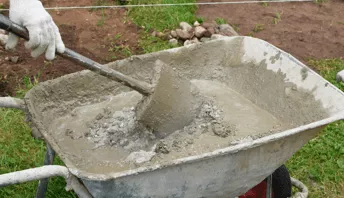
Footings
Information related to installing frost footings for decks
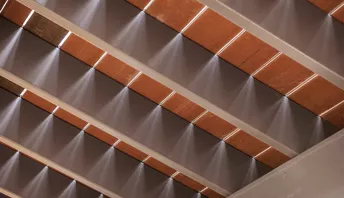
Framing
Learn structural framing methods
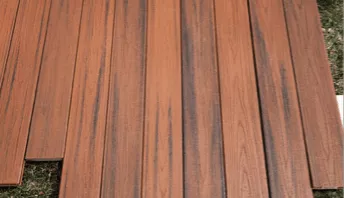
Decking
Learn about wood and composite decking materials
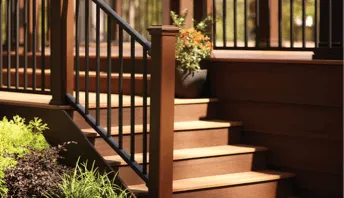
Stairs
An in-depth look at the complex issue of how to build stairs
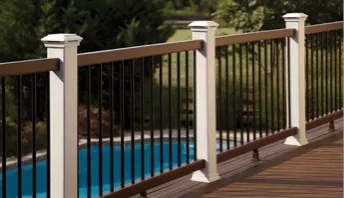
Railings
How to install guardrails and handrails to meet IRC code
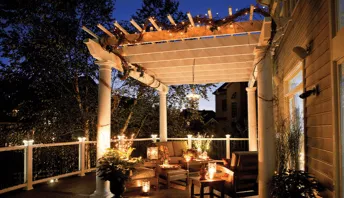
Features
An overview on water drainage, benches, planters and lights
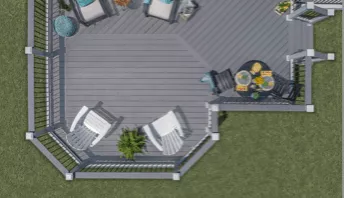
Design
The basics of deck design
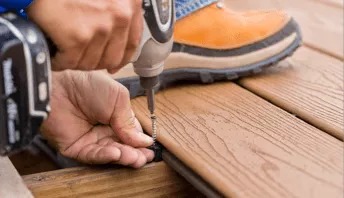
Planning
Learn about permits and working with contractors
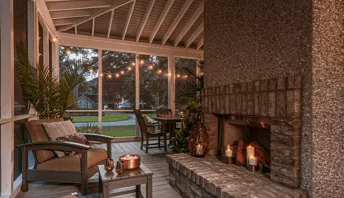
Porches & Patios
Build a covered deck to enjoy all seasons
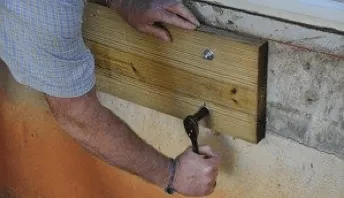
Ledger
Proper attachment techniques
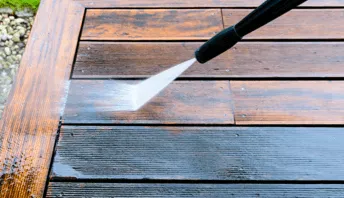
Care
Maintain your deck to maintain your investment
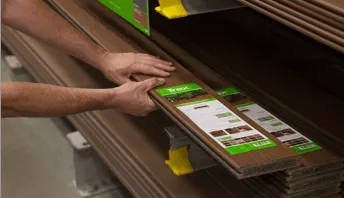
Materials
An overview on water drainage, benches, planters and lights
Hog Wire Deck Railings
Considering hog wire deck railings? Discover the benefits, materials, costs, and installation tips to build a stylish, durable, and code-compliant railing for your outdoor space.
How To Fix Loose Deck Railing and Prevent Wobbly Banisters for Years
Learn how to fix a loose outdoor railing on your deck to avoid future damage.
Steps To Build & Secure A Deck Railing Planter
Railing planters are an easy way to add some color to your deck without taking up space. Follow these simple steps and get started on your railing planters today.
5 Best Ways on How to Hide Trash Cans Outside
Outdoor trash cans can be an unwanted eyesore. Discover how you can easily cover them up and add an extra touch of beauty to your yard.
How to Build an Outdoor Table Yourself
Our DIY guide will show you how to build an outdoor table to entertain guests and make the most out of your deck or patio. Learn more with Decks.com.
Best Plants & Flowers to Brighten Up Your Deck
If you’re looking to brighten up your outdoor space this summer, try adding one of these plants or flowers to your deck or patio.
Explore Articles by Topic

Footings
Information related to installing frost footings for decks

Framing
Learn structural framing methods

Decking
Learn about wood and composite decking materials

Stairs
An in-depth look at the complex issue of how to build stairs

Railings
How to install guardrails and handrails to meet IRC code

Features
An overview on water drainage, benches, planters and lights

Design
The basics of deck design

Planning
Learn about permits and working with contractors

Porches & Patios
Build a covered deck to enjoy all seasons

Ledger
Proper attachment techniques

Care
Maintain your deck to maintain your investment

Materials
An overview on water drainage, benches, planters and lights














